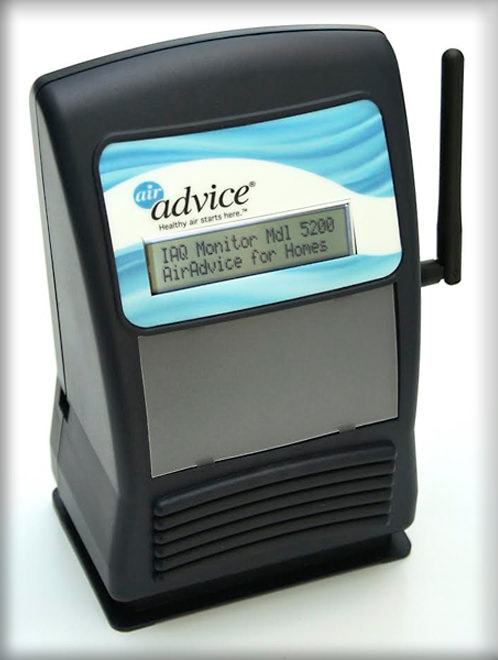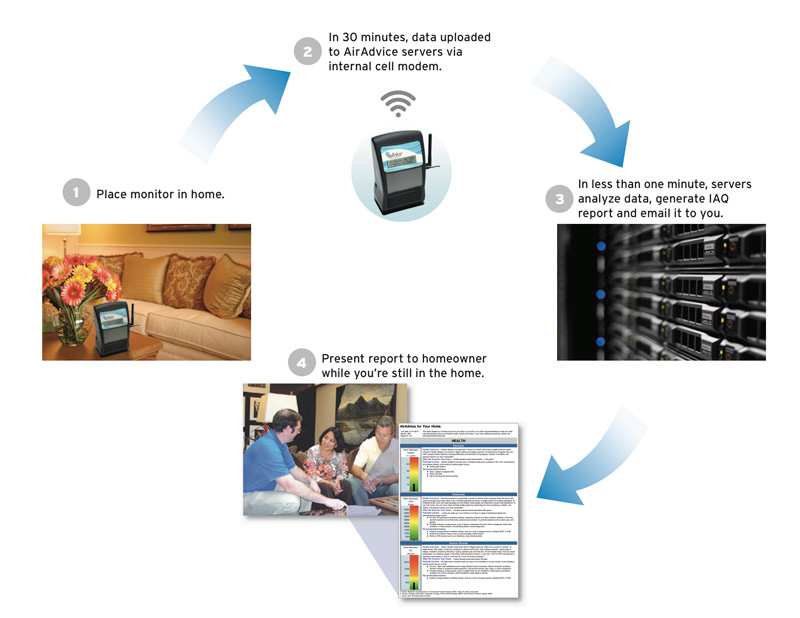AirAdvice for Homes IAQ: Make the Invisible Visible
AirAdvice for Homes™ IAQ is a portable diagnostic system for providing easy, automated assessments of home air quality and energy efficiency. Identify problems having to do with:
Particles
Chemicals (Volatile Organic Compounds)
Carbon dioxide (CO2)
Carbon monoxide (CO)
Temperature
Humidity
More than 90% of all homes have at least one indoor air quality problem. With AirAdvice for Homes, you can solve problems that impact your customers’ health, comfort, and safety.
By making invisible problems visible to the homeowner, you can move forward with solutions that will improve quality of life, including:
Filtration
Ventilation
Air cleaners
Humidifiers / De-humidifiers
Programmable thermostats
Zoning
Planned maintenance agreements
More than just diagnostic technology, AirAdvice for Homes™ is a program that includes business consulting, home IAQ expertise, training, and support materials to help contractors stand apart.
AirAdvice for Homes can help you uncover hidden indoor air quality issues and expand your business through new offerings.
Do I Need an IAQ Test?
Indoor air pollution and its health implications are a rapidly growing concern for families in today’s society. You want your family to be safe from the air pollution problems found in the outside environment, yet you may be unaware that indoor air pollution can have a major effect on your family’s health, comfort, and safety as well.
The EPA has identified indoor air pollution as one of the top five urgent environmental risks to public health. Indoor air pollution contributes to lung disease, including respiratory tract infections, asthma, and lung cancer, and can greatly exacerbate allergy symptoms. If you or a family member suffer from allergies or asthma, or if you have infants or elderly persons living at home, indoor air pollution and its health implications are of even greater concern to you.
Even healthy adults can experience adverse symptoms with as little as a single exposure to indoor air pollution. Some common symptoms are headaches, nausea, sore or scratchy throat, nasal irritation, dry, red, or watering eyes, coughing, and fatigue.
Common indoor air pollutants throughout your home, there could be contaminants that you do not know about that are quietly contributing to air quality problems in every room of the house. There are many factors that can cause indoor air pollution:
Bedrooms – dust mites, pet dander, fragrances, dry-cleaning
Family rooms – tobacco smoke, wood stoves/fireplaces, unvented space heaters
Bathrooms – plumbing leaks, damp flooring and carpeting, excessive moisture, insect debris, viruses and bacteria, household cleaners, air fresheners
Kitchens – cooking smoke, gas appliances, household cleaning agents, insect debris, viruses and bacteria, garbage pails, plumbing leaks
Attics – outdated insulation, old clothing and bedding, asbestos, dust
Garages – paints and solvents, auto exhaust and gasoline fumes, pesticides and herbicides, carbon monoxide, hobby supplies (like vanishes and glues)
Basements – radon, plumbing leaks, viruses and bacteria, dust
Fireplaces – carbon dioxide, carbon monoxide, particle allergens, chemical pollutants, and temperature, humidity, air pressure issues
Yards – pollen, dust, pesticides, herbicides
If you or your family has suffered from any of the symtoms above, or recongnize any of these pollutants in your home, let us help you. Have an AirAdvice for Homes™ indoor air quality test done today in your home. Call us at 781-201-1100 or fillout our MPC Free Home Testing Form selecting the button below.
Frequently Asked Questions
How does the monitor store or communicate the data that is collected?
The monitor stores IAQ data internally, and automatically sends that data to the AirAdvice for Homes servers via internal cellular modem. If cellular service is unavailable, the monitor will hold 2 weeks of data.
Is a secondary test common after improvements are made to the system?
Most often, customers experience noticeable improvements in their home’s IAQ with properly installed, quality equipment, and do not ask for a secondary test.
Do contractors need specific training to be able to perform IAQ testing?
No, the AirAdvice for Homes IAQ system is “plug-and-play”. Simply connect the monitor to a wall outlet, and the IAQ report will be in your email inbox in about 30 minutes. AirAdvice for Homes does provide training in how and where to place the monitor in the home, interpreting the report, and IAQ issues and equipment.
How long does it take to generate the report after the monitor data is downloaded?
The monitor automatically uploads IAQ data to the AirAdvice for Homes servers after 30 minutes. The servers interpret the data, prepare the report, and email the report to the user. This process takes 4-5 minutes, so you will have the report about 35 minutes after plugging in the monitor.
How much does it cost for a contractor to generate a report?
We do not charge per report. MPC Homes program, reports are included in the equipment cost.
Can the monitor be placed in a commercial application also?
Yes. Everything works the same. There is a Commercial Lite report for those placements.
Does the system test for mold?
Not specifically. It tests for conditions that would make mold growth more likely. If those conditions are found, we recommend that the contractor take the next step of placing a mold trap.
Who would benefit from having an IAQ test performed in their home?
Everyone should ensure that they are breathing healthy air in their home. Testing is especially recommended in homes where there are young children or elderly people, people suffering from allergies or asthma, and in situations where you notice any of the common complaint issues mentioned above (see the “common IAQ complaints question” above.)
What are some common IAQ complaints from homeowners?
Some of the more common complaints indicating IAQ problems are: stuffy air, musty or other odors, allergies, asthma, coughing, drafty air, and cold or hot spots in the home.
What does the AirAdvice for Homes system test for?
Temperature, humidity, carbon dioxide (CO2), carbon monoxide (CO), volatile organic compounds (VOCs, which are odors and chemicals), and particulates (dust and dander.)
 Certified EPA Expert
Certified EPA Expert
